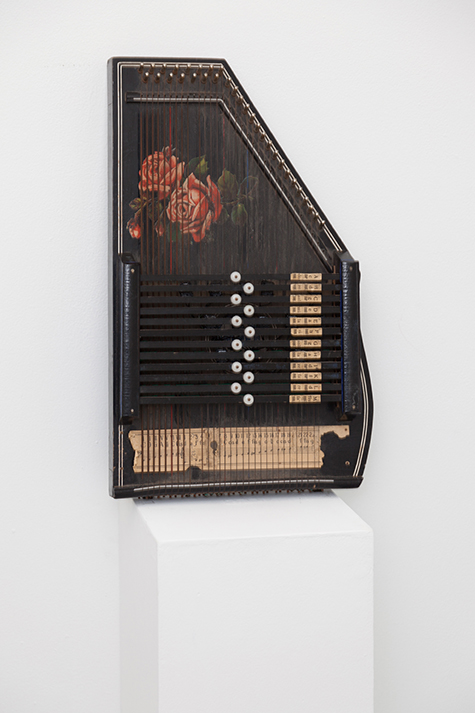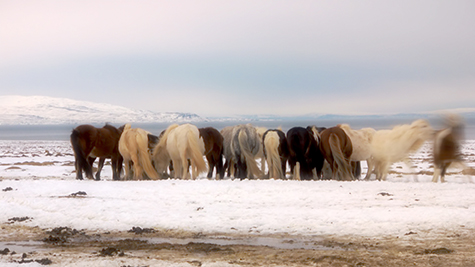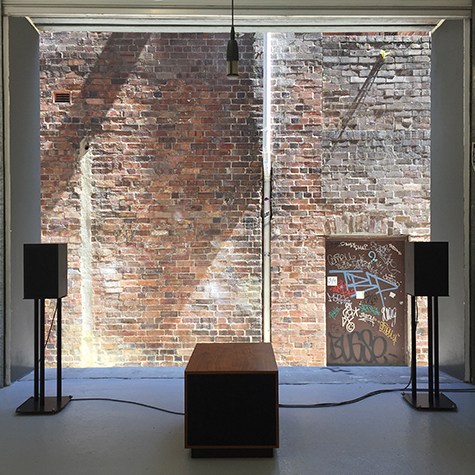The summed hum of time and space
Gail Priest: Tim Bruniges, Drones

Autoharp, Tim Bruniges, Drones
photo Galerie pompom
Autoharp, Tim Bruniges, Drones
Chippendale is a suburb in an amplified state of renovation. Closing Galerie pompom’s door behind me on the Abercrombie Street assault of construction and heavy traffic offers an overwhelming sense of relief. It’s cool in here—white and uncluttered—and there’s a pleasing harmonic hum at Goldilocks-just-right volume. This is the sound of the first of three works that make up Tim Bruniges’ exhibition, Drones.
This extended tone-cluster is emanating from an autoharp propped on a small shelf to the right of the entrance. (An autoharp is not a harp but a zither-like instrument designed so that certain strings will be damped to produce chords.) Bruniges has placed electromagnets over the strings (as with an EBow) to keep them continuously vibrating, creating a potentially endless chord. This first sonic zone is like an aural-cleanser—the sonic equivalent of a tall glass of cool water.
You don’t really need to stay with this work, rather it stays with you as you move through the gallery, its harmonic concentrations shifting subtly according to the mysteries of architectural acoustics. I think of it as a ‘cool’ sound (in terms of temperature, not fashion) because of the way it underpins Bruniges’ second piece, a video work titled Horses.

Horses, Tim Bruniges, Drones
photo courtesy Galerie pompom
Horses, Tim Bruniges, Drones
On a large wide-screen monitor is a beautiful herd of tawny horses amid an equally stunning icy landscape of bluish-greys and white. It’s a breathtaking image but after a moment you notice something that can’t quite be called a movement, more a smearing in time. With an ultra-smooth blurring effect—perhaps closest to the movement of ink in water, or the swirl of smoke—a tail swishes, a mane is tossed and the central animal breaks away from the herd, but there is no clear sense of a beginning or end to the action, just a constant state of edgeless shifting. It’s reminiscent of Daniel Crooks’ confounding and mesmeric shifting of bodies and images through time (see the interview with Crooks), however Bruniges has his own unique technique. You might expect the figurative nature of the image to push against the homogenic thickness required to create a sense of the “dronal,” yet Bruniges has indeed created a successful visual equivalent.
After a few minutes contemplation, you begin to realise that the gallery is actually getting quite noisy. At the far end, the loading bay roller door is open, letting in a not insignificant swathe of real world noise—a garbage truck, impact drilling, shouts from the multiple surrounding construction sites. Facing the opening is a small bench which allows you to sit between two treble speakers with a sub woofer. Suspended above, a microphone connects with a discrete, yet aesthetically pleasing, triode vacuum tube amplifier and audio workstation.

Wall, Tim Bruniges, Drones
photo Galerie pompom
Wall, Tim Bruniges, Drones
Sitting on the bench you try to discern what’s going on. What is outside and what is inside and how is Bruniges combining the two? Admittedly this is not an unfamiliar conceit, but as in Horses, Bruniges distinguishes himself with the quality of the execution. Here it’s all about subtlety—finding the perfect mix of real world and processed sounds. There’s a low rumbling hum coming from the sub—perhaps a pitch-shifted sum of the autoharp and external noises, or maybe even well controlled spatial feedback—but it’s just on the edge of hearing, blending with the external world’s dull roar. It’s the higher frequencies that make occasional cameos, ringing out with a light application of reverb and some sculpted EQ-—the voice of the gallery attendant, the ping of a bottle cap being kicked as someone walks down the lane—rising out of the mix for fleeting moments that just grab your attention and then are gone again.
The open door not only lets in sound but also affords a theatrically framed view of the brick wall on the other side of the narrow lane. The work is titled Wall and this is clearly one reason why, but Bruniges’ sonic treatment also makes a wall of sound. Not in an ‘epic noise’ sense but rather via a fascinating flattening effect, the background and foreground brought into the one sonic plane. Actually, it’s perhaps not so much a wall of sound; rather the processing forms a screen or scrim, through which real world sounds are sieved to create a sense of flatness or uniformity.
Drones are generally associated with extended time frames and a certain thickness or density, yet each of Tim Bruniges’ works offers a surprising succinctness, lightness and clarity in their articulation of the concept. However, the real strength of the exhibition lies in the ways in which the three pieces literally resonate, bringing together internal and external sites in an all-encompassing cross-sensory drone that induces a state of nuanced awareness of both time and space.
–
Tim Bruniges, Drones, Galerie pompom, Sydney, 2 March-3 April
Sydney based visual artist and musician Tim Bruniges works across installation, sound and video, centring on notions of perception, the fallibility of memory and our relationship with time. Often taking the form of site-specific installations, the works attempt to create immersive spaces that allow for a disruption of expected experience. He holds a Master of Fine Arts from COFA, University of New South Wales and a Bachelor of Arts (Mus) with distinction from the University of Western Sydney. He has exhibited works nationally and in the USA, Germany, France, Iceland and Russia and recently has been based in New York following completion of the Greene St Studio artist residency in 2013 awarded by the Australia Council for the Arts (from his website).
RealTime issue #131 Feb-March 2016, web






